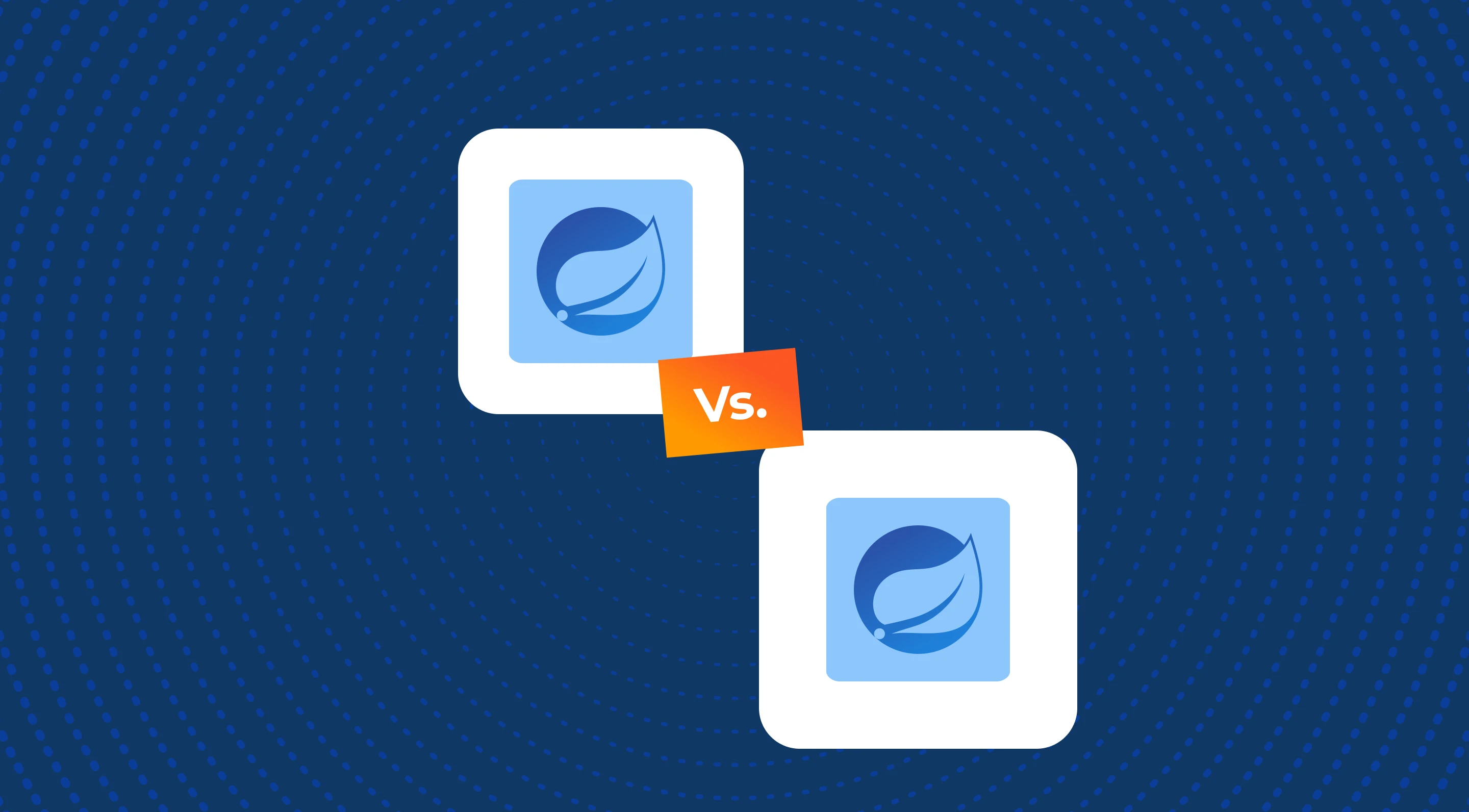SHARE
Spring vs. Spring Boot: A Complete Comparison

Contents
Contents
Spring and Spring Boot are two of the most influential frameworks for Java-based application development, both facilitating the creation of robust, scalable applications. With a substantial 22% market share, the Spring framework is revered as a popular, reputable Java framework.
Spring Boot, developed as an extension of the Spring framework, seeks to streamline Spring applications’ initial setup and ongoing maintenance. It provides an opinionated approach to configuration, enabling developers to get their applications up and running with minimal fuss.
Key Takeaways:
- Spring Boot enhances the Spring framework by simplifying configuration with its convention-over-configuration approach, making it ideal for rapid application development.
- The Spring framework offers extensive customization and control, perfect for complex applications requiring fine-tuned configurations and integration with legacy systems.
- Choosing between Spring and Spring Boot depends on specific project needs, with Spring Boot favored for quick, less complex setups and Spring preferred for detailed, custom applications.
What Is Spring?
The Spring framework is a powerful, versatile tool for building Java applications. As a comprehensive programming and configuration model, Spring provides infrastructure support for developing Java apps. Its core features facilitate the entire development process, from initial setup to deployment and beyond.
- Dependency Injection: One of Spring’s foundational features is Dependency Injection, which promotes loose coupling through the injection of dependencies into components as opposed to components creating or finding their dependencies. This approach simplifies the management of application components and enhances their testability and modularity.
- Aspect-Oriented Programming (AOP): Spring supports AOP, allowing developers to define method-interceptors and pointcuts to cleanly decouple code that implements functionality that should be separated. This results in a more coherent code base where issues such as transaction management, logging, or security are segregated from the main logic.
- Data Access: Spring’s data access framework — part of its broader transaction management support — simplifies the integration of various persistence technologies, from JDBC to ORM frameworks like Hibernate. This abstracts the boilerplate data handling and reduces the repetitive code developers have to write.
Flexibility and customization are core tenets of the Spring framework. It does not impose any specific programming model. Instead, it accommodates and works alongside multiple approaches, from traditional deployment to more modern, reactive styles, ensuring that developers can tailor the framework to their specific needs.
What Is Spring Boot?
Spring Boot is an extension of the Spring framework designed to simplify configuring and deploying Spring applications. It builds upon the robust foundations of Spring by offering a way to organize Spring configurations with minimal developer input, aiming for an out-of-the-box, production-grade setup.
- Simplified Setup and Configuration: Spring Boot provides a range of non-functional features that are standard to large classes of projects (e.g., embedded servers, security, metrics, health checks, and externalized configuration). This simplifies the initial setup process, as developers can start with a minimalist setup and extend functionalities as needed.
- Opinionated Defaults and Auto-configuration: One of the key selling points of Spring Boot is its approach to convention over configuration. Spring Boot comes with pre-configured behaviors based on community best practices. Developers can get started with a default setup that works out of the box but can always override and customize the defaults as the requirements grow or change.
Overall, Spring Boot enhances the Spring ecosystem by providing a pragmatic, opinionated way to set up and run a Spring application, significantly reducing the development time and effort needed to launch a project. This makes it especially appealing for developers looking to quickly deploy applications without sacrificing the flexibility and robustness offered by Spring.
Spring vs. Spring Boot: Key Features and Differences
Spring and Spring Boot serve as cornerstones in Java development but cater to slightly different needs through their unique approaches. Understanding their differences is crucial for selecting the appropriate framework for specific project requirements.
|
Feature |
Spring |
Spring Boot |
|
Approach and Philosophy |
Offers a robust foundation for Java applications, allowing complete control over configurations and setups, promoting flexibility and customization. |
Builds on Spring to simplify the application lifecycle using a convention-over-configuration philosophy, preferring preset, out-of-the-box options. |
|
Configuration Style |
Requires explicit configuration, which gives developers detailed control over application behavior but can increase complexity and setup time. |
Uses auto-configuration and starter kits to reduce the amount of manual configuration needed, making setup quicker and easier by assuming default behaviors based on included libraries. |
|
Development Speed |
Typically slower to configure due to the need for a specific setup, but offers greater control, which can be critical for complex, customized application scenarios. |
Designed for rapid development, enabling quick setup, configuration, and deployment, ideal for projects requiring fast iterations, such as microservices and cloud-native applications. |
|
Ideal Use Cases |
Best suited for applications requiring specific, finely tuned configurations or integration with legacy systems. Useful in educational settings for deep learning. |
Best for applications that benefit from quick development cycles and where default configurations are adequate. Highly suitable for new projects and microservices architecture. |
Code Examples: Spring vs. Spring Boot Configuration Differences
Spring Configuration
Spring Boot Configuration
The Spring example requires explicit configuration for data source setup, while Spring Boot uses properties files with minimal Java configuration, leveraging auto-configuration.
When To Choose Spring or Spring Boot
You can make an informed decision between using Spring or Spring Boot by carefully evaluating the project’s specific needs and the preferences of the development team. Your choice will impact the project’s development timeline, maintainability, and scalability.
- Choosing the Spring Framework: The Spring framework is ideal in scenarios requiring specific, fine-tuned configurations or when integrating with legacy systems that demand a certain level of customization and control. It is also preferable in educational settings where learning the intricacies of Spring is beneficial.
- Advantages of Spring Boot: Spring Boot�’s convention-over-configuration approach is highly advantageous for most modern applications, especially those requiring quick iterations and deployment. Its auto-configuration capabilities make it suitable for microservices, cloud-native applications, and projects requiring rapid prototyping.
- Guidance on Selection: The choice between Spring and Spring Boot should be based on project requirements, team expertise, and specific use cases. Spring Boot is often the better choice for projects that benefit from rapid development and less complex configurations. However, if control and fine-grained configuration are paramount, Spring would be more appropriate.
Best Practices and Tips
Adhering to Spring and Spring Boot best practices is essential to unleash their full potential and ensure maintainable, efficient, and secure code.
Working With Spring
- Embrace Dependency Injection: Use Spring’s dependency injection to decouple your application components, making them easier to manage and test.
- Utilize Spring Profiles: Define different configurations for different environments (development, test, production) using Spring Profiles. This helps in managing environment-specific properties without cluttering your application code.
- Manage Transactions Effectively: Use Spring’s declarative transaction management to ensure you handle database transactions consistently, reducing boilerplate code related to transaction management.
- Avoid Classpath Scanning Overhead: Be specific with your component scans. Limiting the packages Spring has to scan on startup can significantly improve performance.
- Be Cautious with Bean Scope: Understand the scopes of your beans (singleton, prototype, request, session) and use them appropriately to avoid unintended sharing of state or performance issues.
Working With Spring Boot
- Start with Spring Initializr: Use Spring Initializr to bootstrap your project. This tool provides a quick way to set up a project with the desired dependencies, adhering to the latest conventions.
- Understand Auto-configurations: Familiarize yourself with Spring Boot’s auto-configuration mechanism. While it’s helpful, overriding these defaults when needed can help optimize your application’s configuration.
- Keep Your application.properties or application.yml Organized: These files can proliferate. Keep them organized and commented for ease of maintenance.
- Monitor and Manage Your Application: Leverage Spring Boot’s actuator and metrics to monitor and manage your application’s health, metrics, and profile data during runtime.
- Avoid Common Pitfalls: Only override Spring Boot defaults if you have a specific reason, invest appropriate time in learning the framework before you dive in, and don’t overuse annotations.
Conclusion
Spring offers deep control and extensive customization options suitable for complex applications that require fine-tuned configurations. However, Spring Boot accelerates application development and simplifies the operational overhead with its convention-over-configuration approach, making it ideal for newer, microservices-oriented projects that value rapid deployment.
Both frameworks strongly support database operations, transaction management, and security, making them indispensable in the modern software development landscape. Depending on your project’s specific requirements, team expertise, and development timelines, either Spring or Spring Boot can be an excellent choice.
If you’re looking to dive deeper or require assistance with their Java-based projects, Flatirons offers custom enterprise software development services tailored to your needs.
Frequently Asked Questions
What are the primary benefits of using Spring Boot over the Spring framework?
Spring Boot simplifies the development process by providing an opinionated approach to configuration with auto-configuration, eliminating much of the manual setup required in the Spring framework. This leads to faster development times, easier maintainability, and a quicker start for new projects.
How does Spring Boot enhance application security compared to Spring?
Spring Boot integrates security seamlessly with starters such as Spring Security, which provides robust authentication and authorization capabilities. While Spring also supports Spring Security, Spring Boot automatically configures security settings, offering sensible defaults that can be customized.
Can Spring and Spring Boot be used together in the same project?
Yes, Spring Boot will work on top of the Spring framework and enhance its functionality, not replace it. It simplifies many of Spring’s manual configurations and adds auto-configuration features. Projects can leverage both frameworks’ strengths, using Spring for fine-grained control where needed and Spring Boot for ease of configuration and setup.
What is the best way to handle database migrations in Spring Boot?
Spring Boot works well with database migration tools like Flyway or Liquibase. These can be integrated via Spring Boot starters, which automatically configure the chosen tool to manage database migrations as part of the application startup process, ensuring the database schema is always up to date.
How can developers optimize Spring Boot applications for production?
To optimize Spring Boot for production:
- Use Spring Boot’s production-ready features like the actuator for monitoring and management.
- Customize the auto-configuration settings as needed to suit production requirements.
- Review and minimize logging levels to avoid performance overhead.
- Employ caching strategies to reduce database load.
- Ensure that application properties are externalized and secure.
Custom Software Development Services
Flatirons offers custom development services tailored for your unique business needs.
Get the CEO's Take
Handpicked tech insights and trends from our CEO.
Custom Software Development Services
Flatirons offers custom development services tailored for your unique business needs.
Get the CEO's Take
Handpicked tech insights and trends from our CEO.

Perl vs Python: Choosing the Right Scripting Language
Flatirons
Apr 20, 2025
IoT Database: Manage Connected Device Data Efficiently
Flatirons
Apr 14, 2025
Proof of Concept Template: A Step-by-Step Guide
Flatirons
Mar 26, 2025
Objective C vs Swift: Which is Better for iOS App Development?
Flatirons
Mar 25, 2025
Scala vs Kotlin: Comparing the Functional Programming Giants
Flatirons
Mar 22, 2025
IoT Smart City Solutions: Transforming Urban Living
Flatirons
Mar 17, 2025